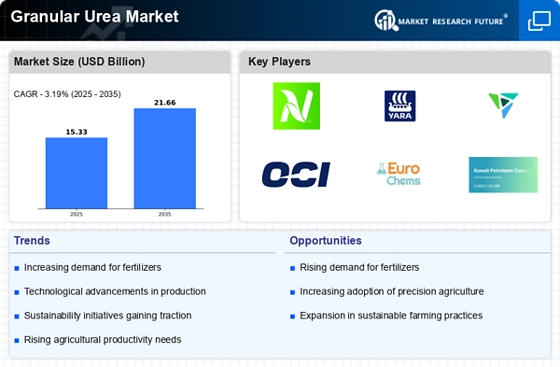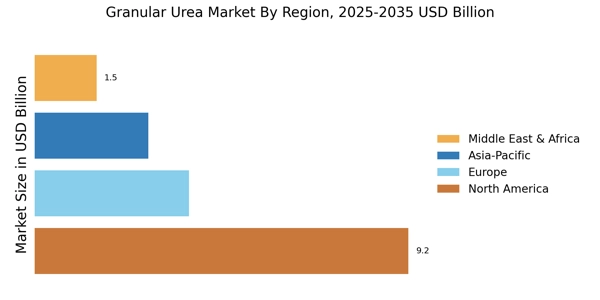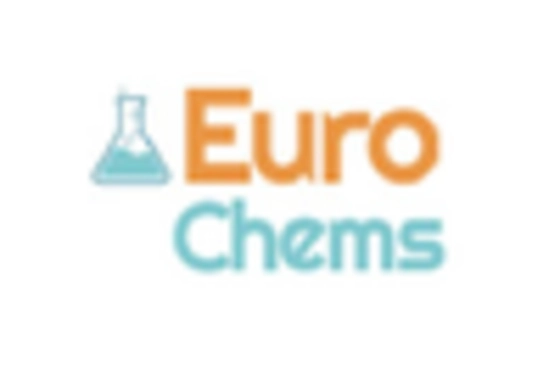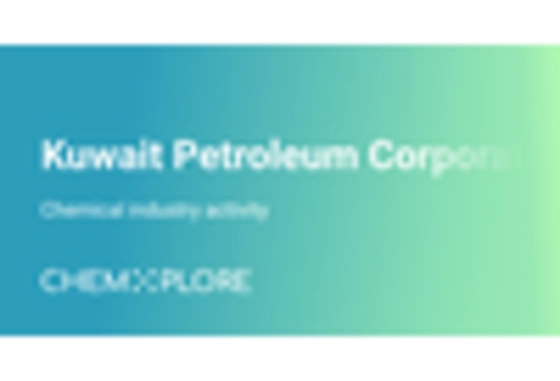Rising Food Demand
The Granular Urea Market is experiencing a surge in demand due to the increasing global population and the corresponding rise in food requirements. As agricultural practices intensify to meet these needs, the demand for nitrogen-based fertilizers, particularly granular urea, is expected to grow. According to recent estimates, the world population is projected to reach approximately 9.7 billion by 2050, necessitating a significant increase in food production. This scenario compels farmers to adopt fertilizers that enhance crop yields, thereby driving the Granular Urea Market. Furthermore, the trend towards higher protein diets in developing regions is likely to further amplify the need for effective fertilizers, positioning granular urea as a critical component in modern agriculture.
Government Initiatives and Subsidies
Government policies and initiatives play a pivotal role in shaping the Granular Urea Market. Many countries are implementing subsidies and support programs aimed at promoting the use of fertilizers to boost agricultural productivity. For instance, various governments have introduced financial incentives for farmers to utilize nitrogen fertilizers, including granular urea, to enhance crop yields. These initiatives not only encourage the adoption of fertilizers but also aim to ensure food security. In some regions, the government has set targets for agricultural output, which further necessitates the use of effective fertilizers. As a result, the Granular Urea Market is likely to benefit from these supportive measures, fostering growth and stability in the sector.
Environmental Regulations and Sustainability
The Granular Urea Market is increasingly influenced by environmental regulations aimed at promoting sustainable agricultural practices. As concerns regarding soil health and water quality rise, regulatory bodies are imposing stricter guidelines on fertilizer usage. Granular urea, known for its efficiency in nitrogen delivery, is often favored in sustainable farming practices. The market is witnessing a shift towards products that minimize environmental impact while maximizing crop yield. This trend is supported by research indicating that optimized fertilizer application can lead to reduced nitrogen runoff, thereby protecting water resources. Consequently, the Granular Urea Market is adapting to these regulations, potentially leading to innovations in product formulations and application methods.
Increasing Adoption of Precision Agriculture
The Granular Urea Market is witnessing a notable shift towards precision agriculture, which emphasizes the efficient use of resources to maximize crop productivity. This approach involves the application of fertilizers, including granular urea, based on specific crop needs and soil conditions. The adoption of precision agriculture technologies, such as soil sensors and data analytics, enables farmers to apply granular urea more effectively, reducing waste and enhancing yield. Reports indicate that the precision agriculture market is expected to grow significantly, which will likely drive the demand for granular urea as farmers seek to optimize their fertilizer use. This trend not only supports economic viability for farmers but also contributes to sustainable agricultural practices.
Technological Innovations in Fertilizer Production
Technological advancements are significantly transforming the Granular Urea Market. Innovations in production processes, such as the development of more efficient synthesis methods, are enhancing the quality and reducing the costs of granular urea. For instance, the introduction of new catalytic processes has improved nitrogen conversion rates, leading to higher yields of granular urea. Additionally, advancements in coating technologies are allowing for controlled-release formulations, which optimize nutrient delivery to crops. These innovations not only improve the effectiveness of granular urea but also align with the growing demand for precision agriculture. As a result, the Granular Urea Market is poised for growth, driven by these technological enhancements.


















Leave a Comment